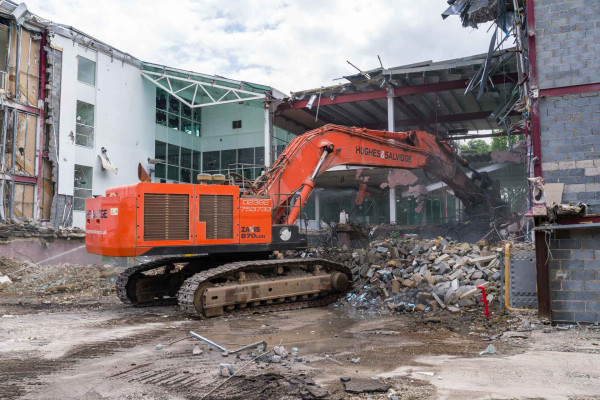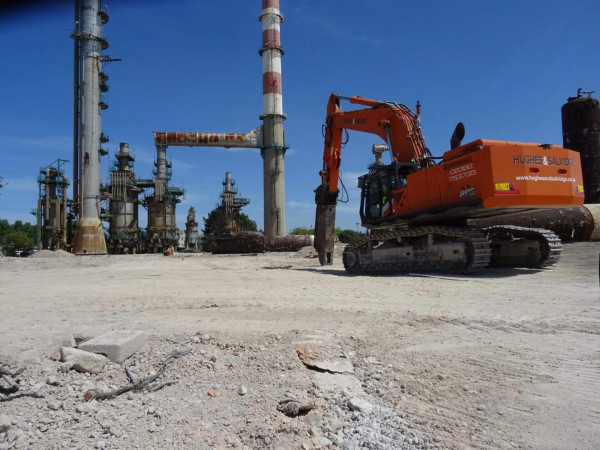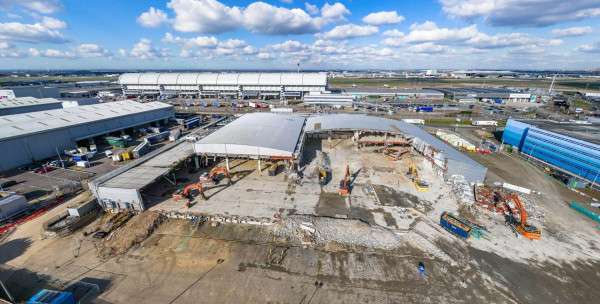Specialist Methods of Demolition
17th October 2025
Demolition of a building or structure requires careful consideration and the support of a dedicated demolition company. Different methods of demolition may be employed depending on a number of factors such as the size and position of the structure, whether it contains asbestos or precious metals, and whether it has a steel or concrete frame.
At Hughes and Salvidge, we carry out demolition work on a variety of building structures and types, employing a range of specialist demolition methods, as required, to do so efficiently and effectively.
Each project is different, with its own unique structure, setting, environment and requirements, presenting its own challenges. These variable elements mean that each project needs to be approached individually, with different methods of demolition being utilised accordingly.
How do we identify the demolition methods needed?
- We conduct a site visit during a tender period, plus a pre-start meeting in advance of each project, to gather all the information we need about the site, structures, environment and requirements. Using this information, Risk Assessments are produced to identify any potential hazards.
- In response to the Risk Assessments, we select demolition methods that will control the highlighted risks, and present this information within a Method Statement for the clients’ perusal.
- If our tender for a project is successful, we will formally agree all elements of the work - including the demolition methods - with the client.
- All of our demolition work is carried out to BS6187:2011 and all work complies with all applicable legislation, Guidance Notes, Acts, British Standards and Approved Codes of Practice. See our health & safety certifications for more information.
.
Superstructure and substructure demolition - what’s involved?
- The Method Statement includes details of any service disconnections required ahead of asbestos and hazardous material removal within the building(s). This is before a soft strip can take place, followed by a superstructure demolition of the building and then a substructure demolition of the floor slab and foundations.
- Soft strip includes the removal of all fixtures and fittings, usually by hand and with the use of hand tools, such as crowbars and Stanley knives, or 110v power tools, such as reciprocating saws or angle grinders.
- The superstructure demolition of a project is unique, and methods used to demolish the structure depend on many factors, such as size of building, existing condition of the building, and vicinity of the building to other structures and surrounding environmental elements.
- With larger structures, chimney stacks or bridges, where plant cannot be deployed safely in demolition, explosive demolition methods are used. We use a specialist, certified contractor to carry out the weakening and explosion of the structure after we have soft stripped the building. We return when the site has been made safe after the explosion and carry out the clean-up of the site debris with our plant.
- Hughes and Salvidge also have extensive experience of ‘system’ builds and have demolished many schools and public sector buildings that incorporated various methods in their construction.
- Such systems inevitably produce risks in regard to asbestos, in both panels and columns, and Hughes and Salvidge have a wealth of knowledge and experience in managing the removal and disposal of asbestos materials prior to demolition of any building.
- With high HSE training standards and strategic project planning, we ensure safe removal with minimal disruption. Totally independent UKAS-approved analysts are employed to undertake air sampling / fibre counting and bulk sampling in full compliance with EN450001 to ensure that the work is carried out in a completely safe manner.

What specialist methods of demolition do we employ?
The method of demolition chosen depends on several factors, including the size and location of the building, the materials it is made of, the surrounding environment, and any safety concerns.
Deconstruction:
This is our most commonly-utilised method of demolition and involves taking a building apart piece by piece in order to salvage materials for reuse or recycling. This method is often used for historic buildings or buildings that contain valuable materials.
High-reach excavator:
A high-reach excavator is a demolition machine that has a long arm with a specialised attachment at the end, such as a pulveriser, cracker or shear. This method is often used for taller buildings or buildings that need to be demolished in a precise manner.
Implosion
This is a controlled demolition method where explosives are used to collapse a building in on itself. The explosives are strategically placed throughout the structure to create a sequence of controlled explosions that bring the building down.
Soft stripping:
This is a method of demolition usually undertaken at the start of a project, and involves operatives using handheld tools to dismantle some elements of a building piece by piece. This is often used for buildings that need to be taken apart carefully in order to preserve certain elements.
Get in touch
Please get in touch to discuss your demolition project needs with us, or check out our Demolition Services and other projects we’ve worked on…



